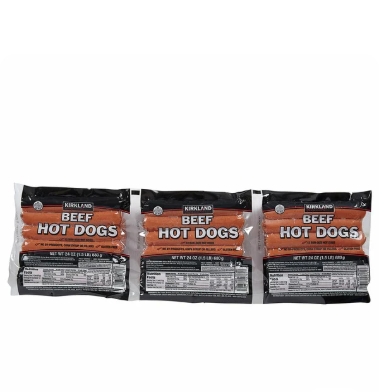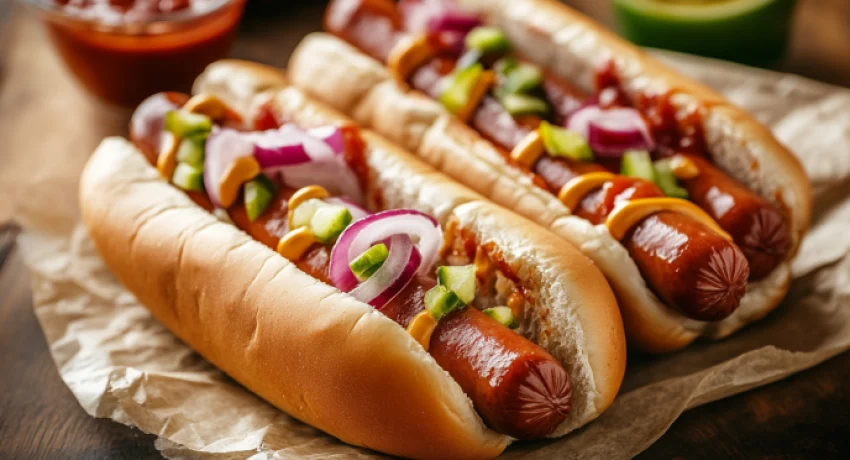
Kirkland Signature Beef Hot Dogs, 12 Links, 1.5 lbs, 3-count
- 12 bun-size hot dogs per package; 24 oz package; 3-pack.
How Costco’s Signature Franks Became a Cult Favorite Without Anyone Noticing
In the sprawling landscape of American cuisine, few foods inspire as much passionate debate as the humble hot dog. Yet amid the squabbles over regional styles and condiment combinations, a quiet revolution has been simmering in the food courts and refrigerated aisles of Costco warehouses nationwide. Kirkland Signature hot dogs have become the unexpected gold standard for affordable, high-quality franks that punch well above their weight class.
As a lifelong hot dog enthusiast who has sampled everything from Chicago’s finest to New York’s iconic street carts, I’ve developed a somewhat embarrassing secret: my favorite hot dog comes from Costco. And I’m not alone. What makes these warehouse wieners so special? Let’s dive deep into the world of Kirkland Signature hot dogs—their origins, composition, cooking methods, and why they’ve developed such a devoted following.
The Mysterious Origins: Who Actually Makes Kirkland Hot Dogs?
The question of who manufactures Kirkland Signature hot dogs has been the subject of speculation for years. Costco, like many retailers with private label brands, doesn’t manufacture its own products but partners with established producers. For their hot dogs, Costco previously worked with Hebrew National, but in 2008, they made a significant switch.
Today, Kirkland Signature hot dogs are produced by a company called CJ Foods, which is not widely known to consumers but is a major player in the meat processing industry. This partnership allows Costco to maintain strict quality control while keeping prices remarkably low—a hallmark of the Kirkland Signature brand philosophy.
The switch wasn’t just about business relationships. It represented a fundamental change in the product itself, moving from Hebrew National’s kosher beef dogs to Kirkland’s current all-beef formulation. This transition sparked initial concern among loyal customers, but the quality of the new product quickly won over skeptics.
What’s Actually Inside These Popular Franks?
One of the most common questions about any hot dog is: what exactly am I eating? With Kirkland Signature hot dogs, the answer is refreshingly straightforward.
Kirkland Signature beef hot dogs are made from 100% beef with no fillers, corn syrup, or by-products. The ingredient list is remarkably short compared to many competitor products: beef, water, salt, spices, dextrose, garlic, sodium phosphate, paprika extract, and sodium nitrite.
This simplicity is part of what makes them special. While many budget hot dogs bulk up their products with mechanically separated meat, soy protein, or other fillers, Kirkland dogs contain only pure beef. This contributes to their distinctive snap and juicy texture that rivals much more expensive brands.
The beef itself comes from muscle meat—not scraps or mystery parts that give hot dogs their questionable reputation. This commitment to quality ingredients is especially remarkable given their price point, which we’ll explore later.
Nutritional Breakdown: How Do They Stack Up?
Let’s face it—hot dogs aren’t health food. But within the category, some options are better than others. Each Kirkland Signature beef hot dog contains approximately:
- 170 calories
- 15g of fat (6g saturated)
- 40mg of cholesterol
- 680mg of sodium
- 2g of carbohydrates
- 0g of sugar
- 7g of protein
These numbers put them roughly in the middle of the pack for beef hot dogs. They’re not low-calorie or low-sodium by any means, but they don’t contain the excessive amounts of either that you might find in some competing products.
One quarter-pound Kirkland hot dog from the Costco food court contains slightly more—approximately 570 calories including the bun, but this varies depending on condiments added.
For those with dietary restrictions, it’s worth noting that Kirkland Signature hot dogs are gluten-free, though they are produced in facilities that process other products containing gluten, so those with severe celiac disease should exercise caution.
The Nitrate Question: Preservation vs. Purity
One controversial aspect of Kirkland hot dogs—and most conventional hot dogs—is their use of sodium nitrite as a preservative. Sodium nitrite serves several important functions: it prevents bacterial growth (particularly Clostridium botulinum, which causes botulism), maintains the pink color we associate with hot dogs, and contributes to flavor.
However, nitrates and nitrites have come under scrutiny for their potential health impacts, particularly their association with increased cancer risk when consumed in large quantities over time. This has led to the rise of “nitrate-free” hot dogs in the marketplace.
Kirkland Signature hot dogs do contain sodium nitrite, which may be a consideration for consumers looking to avoid this ingredient. However, the levels used comply with FDA regulations, and the scientific consensus suggests that moderate consumption as part of a varied diet poses minimal risk for most people.
For those specifically seeking nitrate-free options, Kirkland does not currently offer an alternative, though the broader marketplace has many such products available at premium prices.
The Economics of Excellence: Why Are They So Affordable?
Perhaps the most remarkable aspect of Kirkland Signature hot dogs is their price. At most Costco locations, a pack of Kirkland Signature beef hot dogs (typically containing 12-14 hot dogs for a total of 3.81 pounds) costs around $14.99, which translates to roughly $1.25 per hot dog or less.
This pricing is significantly lower than comparable all-beef hot dogs from brands like Nathan’s or Hebrew National, which can cost upwards of $2-3 per hot dog at regular supermarkets.
The famous Costco food court hot dog and soda combo, priced at $1.50 since 1985 (a price that has miraculously withstood decades of inflation), features a quarter-pound Kirkland hot dog that would likely cost $4-5 at a sporting event or theme park.
How does Costco maintain this pricing? Several factors come into play:
- Vertical integration: By controlling more of the supply chain, Costco eliminates middlemen and reduces costs.
- Scale: The sheer volume of hot dogs Costco sells—both packaged and in their food courts—allows for bulk production efficiencies.
- Loss leader strategy: The food court hot dogs specifically operate as a customer retention tool, with Costco willing to make minimal profit to keep members happy and shopping.
- Membership model: Costco’s annual membership fees provide a revenue stream that allows them to keep margins lower on actual products.
This combination of factors creates a rare win-win: consumers get a premium product at a budget price, while Costco builds loyalty and drives membership renewals.
The Taste Test: How Do They Compare to Major Brands?
When compared to other major hot dog brands, Kirkland Signature holds its own remarkably well, often outperforming much more expensive options in blind taste tests.
Compared to Nathan’s Famous, Kirkland hot dogs have a similar robust beef flavor but a slightly smoother texture. Nathan’s dogs tend to have a more pronounced garlic note, while Kirkland’s have a more balanced spice profile.
Against Oscar Mayer’s all-beef offering, Kirkland presents a more substantial bite and juicier interior. Oscar Mayer dogs often have a softer texture and milder flavor that some prefer for its versatility with toppings.
Hebrew National, the former supplier to Costco, produces a kosher dog with a distinctive flavor that many enthusiasts still prefer. The primary differences are in the spice blend and slightly firmer texture of Hebrew National’s product.
Ball Park Franks, another popular competitor, tends to be softer and sweeter than Kirkland’s more savory profile.
In terms of texture, Kirkland hot dogs strike a perfect balance—they have enough “snap” when you bite into them without being tough, and they’re juicy without being mushy. This textural sweet spot is difficult to achieve and represents one of their strongest qualities.
The Casing Conundrum: Natural vs. Artificial
Hot dog aficionados often emphasize the importance of casings in creating the perfect frank. Natural casings, typically made from cleaned animal intestines, provide the distinctive “snap” that many enthusiasts prize. Artificial casings, usually made from collagen or cellulose, offer consistency and are removed before packaging in “skinless” varieties.
Kirkland Signature hot dogs use artificial casings rather than natural ones. This choice allows for more consistent cooking results and texture across millions of hot dogs. While purists might prefer the variable snap of natural casings, the artificial casing used for Kirkland dogs creates a reliable, satisfying bite that appeals to a broad audience.
This approach aligns with Kirkland’s overall philosophy: delivering consistent quality at scale rather than artisanal variation. The result is a hot dog that performs reliably whether grilled at a backyard barbecue or microwaved for a quick lunch.
Cooking Perfection: The Best Ways to Prepare Kirkland Hot Dogs
The beauty of Kirkland hot dogs lies partly in their versatility—they perform well across various cooking methods. Here are the optimal approaches for different situations:
Grilling (The Gold Standard)
For the ultimate Kirkland hot dog experience, grilling is unmatched. The combination of smoke flavor and caramelization creates depth that other methods can’t replicate. For best results:
- Preheat your grill to medium heat (about 350°F)
- Score the hot dogs with shallow diagonal cuts about an inch apart (this prevents bursting and creates more surface area for flavor development)
- Grill for 5-7 minutes, turning occasionally for even cooking
- Look for light char marks on all sides without burning
The resulting dog will have a slightly crisp exterior, juicy interior, and enhanced smoky flavor that complements the beef and spice blend perfectly.
Boiling (The Traditional Method)
While purists might scoff, boiling produces consistently juicy results and is incredibly forgiving:
- Bring a pot of water to a gentle boil
- Add hot dogs and reduce to a simmer
- Cook for 4-5 minutes until heated through
- Remove with tongs and blot gently to remove excess moisture
Boiled Kirkland hot dogs maintain their juiciness but lack the flavor development of grilled or pan-fried versions. This method works well when preparing for children or those who prefer a milder flavor profile.
Pan-Frying (The Indoor Alternative)
When grilling isn’t an option, pan-frying offers similar benefits with more convenience:
- Heat a skillet over medium heat with a small amount of oil
- Add hot dogs and cook for 8-10 minutes, turning regularly
- For extra flavor, add a splash of water and cover briefly to steam before uncovering to finish browning
This method creates nice browning while maintaining interior moisture—a solid compromise when grilling isn’t possible.
Microwave (The Quick Fix)
While not ideal for flavor development, microwaving works in a pinch:
- Wrap hot dog loosely in a paper towel
- Microwave on high for 30-45 seconds
- For better results, finish in a hot skillet for exterior browning
The microwave method sacrifices texture for convenience but can be improved with a hybrid approach that finishes the dogs in a pan.
Storage Secrets: Freezing and Shelf Life
Kirkland Signature hot dogs come in larger quantities than many families can consume in a short period, making proper storage essential.
In their original packaging, unopened Kirkland hot dogs can be refrigerated until the “use by” date printed on the package—typically about two months from production. Once opened, they should be consumed within a week for optimal quality.
For longer storage, freezing is an excellent option. Kirkland hot dogs freeze exceptionally well, maintaining their quality for up to two months when properly stored. For best results:
- If freezing the entire unopened package, simply place it in the freezer
- For opened packages, wrap tightly in plastic wrap or aluminum foil, then place in a freezer bag with excess air removed
- For individual hot dogs, wrap separately and store in a freezer container
When ready to use, thaw frozen hot dogs overnight in the refrigerator rather than at room temperature to prevent bacterial growth. In a pinch, they can be cooked directly from frozen, though this may result in uneven heating.
The Costco Food Court Connection
No discussion of Kirkland hot dogs would be complete without mentioning their most famous showcase: the Costco food court. The quarter-pound hot dog and soda combo for $1.50 has become not just a meal but a cultural institution.
These food court hot dogs are slightly different from the packaged version available in the refrigerated section. The food court dogs are quarter-pounders (larger than the packaged variety) and are prepared using specialized equipment that steams both the hot dog and the bun simultaneously.
The resulting hot dog has become so iconic that Costco sells approximately 100 million hot dog combos annually across their food courts—more than four times what all Major League Baseball stadiums combined sell during their season.
This popularity led to one of the most famous quotes in retail history. When a Costco executive suggested raising the price of the hot dog combo to then-CEO Jim Sinegal, he reportedly replied, “If you raise the price of the hot dog, I will kill you.” Current CEO Craig Jelinek has maintained this philosophy, understanding that the hot dog combo represents more than just food—it’s a tangible symbol of Costco’s value proposition.
Availability: Where to Find Them Beyond the Warehouse
Kirkland Signature products are designed as Costco exclusives, creating an incentive for membership. Consequently, the only authorized retailer for Kirkland hot dogs is Costco itself. They’re available in most Costco locations both in the refrigerated section and cooked in the food court.
For those without a Costco membership, options are limited. While some Kirkland products have appeared on Amazon through third-party sellers, hot dogs are perishable and rarely available through these channels. Some members do resell Kirkland products through local classified ads or neighborhood apps, but freshness and food safety become concerns with unofficial distribution.
This exclusivity is part of Costco’s strategy—creating “treasure hunt” products that drive membership sales and warehouse visits. For hot dog enthusiasts, the quality-to-price ratio of Kirkland Signature hot dogs alone can justify the annual membership fee of $60-120, particularly for families who entertain frequently.
The Cultural Phenomenon: Why Have They Developed a Cult Following?
The devotion to Kirkland hot dogs extends beyond mere appreciation into the realm of cult following. Social media groups dedicated to Costco finds regularly feature passionate discussions about these franks. Food bloggers conduct elaborate taste tests comparing them to premium brands. Costco’s food court hot dogs even have their own hashtags and meme culture online.
What explains this level of enthusiasm for what should be a mundane grocery item?
First, there’s the value proposition—the rare case where the cheaper option is genuinely as good as or better than premium alternatives. This creates a sense of being “in on a secret” that savvy consumers love to share.
Second, there’s consistency. In a world of fluctuating quality and shrinking products, Kirkland hot dogs have maintained their size, quality, and price over many years, building trust with consumers.
Third, there’s the communal experience. Sharing a Costco hot dog after shopping has become a ritual for many families, creating nostalgic associations that transcend the food itself.
Finally, there’s the counterintuitive nature of finding exceptional quality in a bulk warehouse setting, challenging assumptions about where “good food” comes from. This subversion of expectations creates conversation and converts skeptics into evangelists.
The Final Verdict: Are Kirkland Hot Dogs Actually Good?
After examining every aspect from ingredients to preparation methods, the evidence points to a clear conclusion: Kirkland Signature hot dogs represent one of the most remarkable value propositions in modern grocery retail.
They combine quality ingredients, skillful manufacturing, consistent performance, and exceptional price in a way that few other products—hot dogs or otherwise—manage to achieve. While they might not satisfy those seeking artisanal, small-batch franks with natural casings, they decisively outperform their direct competitors in the national brand space.
For everyday consumption, special occasions, and especially large gatherings, Kirkland hot dogs offer a rare combination of crowd-pleasing flavor and budget-friendly pricing. Their versatility across cooking methods makes them practical for various situations, while their clean ingredient list provides reassurance in a category often associated with mystery meats.
Perhaps most tellingly, they’ve earned respect from food professionals and enthusiasts who have no reason to champion a warehouse store product except for its genuine merit. In blind taste tests against much more expensive competitors, they consistently perform at or near the top, challenging preconceptions about price and quality correlation.
In the final analysis, Kirkland Signature hot dogs aren’t just good “for the price”—they’re objectively good by any reasonable standard, representing one of those rare instances where the mass-market option stands shoulder-to-shoulder with premium alternatives. For the hot dog enthusiast on a budget—or anyone who appreciates value without sacrificing quality—they remain an unbeatable choice that has earned their cult status through consistent excellence rather than marketing hype.
Whether enjoyed at a summer barbecue, a quick weeknight dinner, or as part of the iconic Costco food court experience, Kirkland hot dogs continue to prove that sometimes the best things come in simple packages with straightforward ingredients and no pretension—just honest quality at a remarkable price.




